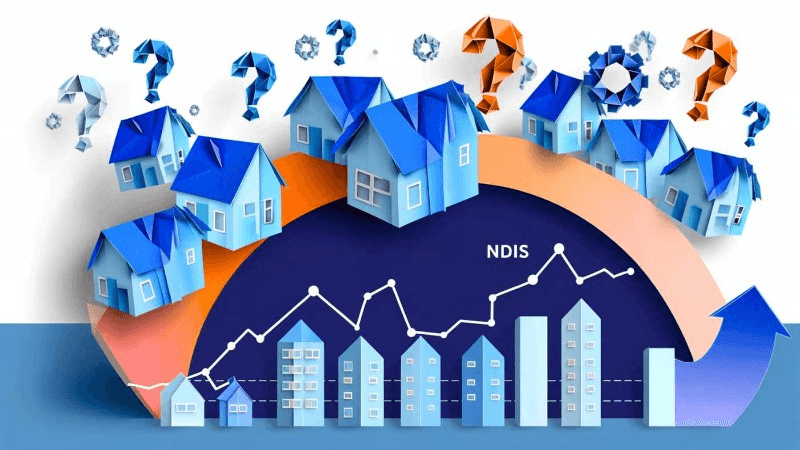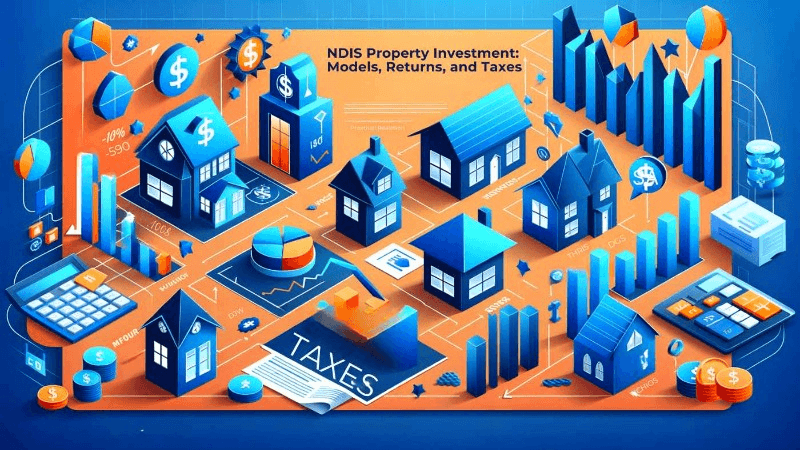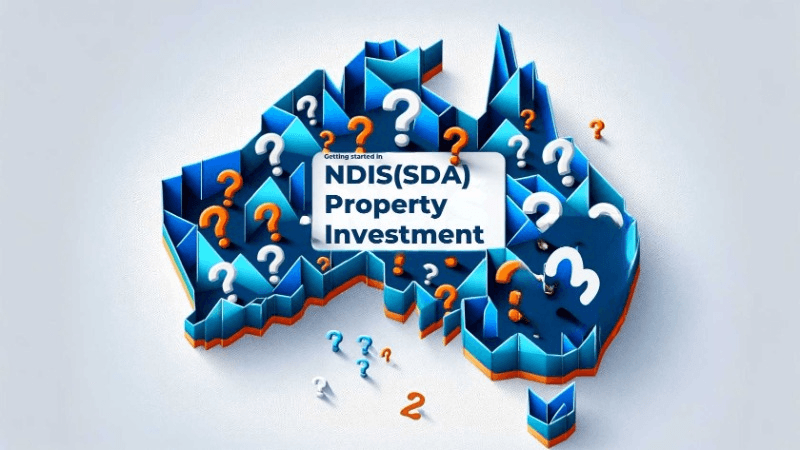NDIS Property Investment Guide: How to Invest in SDA Safely
by Michael Fuller
July 9, 2024
Have you ever felt overwhelmed by the abundance of information (and misinformation) surrounding investing in NDIS specialist disability accommodation (SDA) housing?
You’re not alone. Conflicting advice, hidden risks, and ever-changing regulations can leave even the most seasoned investor feeling lost.
But what if there was a way to cut through the noise and confidently chart your course? This guide is your compass, providing clear, actionable insights to help you navigate your NDIS property investment journey.
Whether your primary interest is in securing a SDA participant to rent your SDA property (obviously this is very important) or choosing the best paying NDIS SDA property types (duplex, house or unit etc) and SDA tenant category (e.g. robust, high physical support); we have you covered in this comprehensive guide.
In conjunction with this guide, I would also encourage you to dive deep into the SDA supply and demand data so you are well informed when someone tries to convince you why a “5 bedroom… Robust Design… group disability home (as opposed to one tenant only)… 5 days by plane from the nearest hospital” is the best investment for high returns this year. Obviously this would be a disaster. And if you don’t know why…I promise you by the end of this article you will cringe.
I may be exaggerating with this example but I can assure you there is a huge amount of ignorance driving investment in SDA housing and I want to make sure you don’t make the same mistakes.
Remember, the returns are simply unbeatable if you get it right.
SDA Help was established to guide you through all the traps, the myths and the data.
Key Takeaways
Aspect | Key Takeaway |
|---|---|
Returns | Potential for higher returns than traditional property investments, but with increased risk from vacancies or dodgy builders. |
Suitability | Not suitable for all investors; requires careful research and consideration of high returns, loan, and property. |
Benefits | Provides secure income stream, supports people with disabilities, and offers tax benefits. |
Risks | Vacancy risk, potential changes in NDIS funding, and complex regulatory environment. |
Costs | Higher upfront costs than traditional property investments. |
Too busy to read this whole report?
Here’s what you need to know in summary.
- Investing in NDIS properties offers a unique opportunity to contribute positively to society by providing high-quality accessibly housing for people with disabilities while also potentially securing a stable and attractive return on investment.
- Before diving into NDIS or SDA property investment, it's crucial to understand the NDIS and SDA housing schemes fully, including the benefits they offer and the specific standards and requirements that properties must meet to be eligible.
- Key considerations for investors include assessing the risks, understanding the criteria for selecting suitable properties, and ensuring that any potential investment in homes meets SDA standards to qualify for funding by the SDA participant (Tenant).
- Financing and cost considerations play a significant role in NDIS property investment. It's important to explore different financing models, understand the tax implications, and consider the long-term returns and costs associated with owning an NDIS investment property.
- Engaging with experts in the field, such as SDA investment advisors who specialise in NDIS investments or SDA providers who manage the tenant, can provide valuable insights and help navigate the complexities of investing in it
Understanding the NDIS and SDA Housing
NDIS Basics
The National Disability Insurance Scheme (NDIS) helps Australians with disabilities. It provides funds for necessary support and services. This includes SDA housing.
SDA stands for Specialist Disability Accommodation. It’s designed for those with extreme functional impairment or very high needs. Not all NDIS participants qualify.
To access SDA, one must meet specific eligibility criteria set by the NDIS. The process can seem daunting at first. But understanding it is crucial for making informed decisions about property investment in this sector.
SDA Investment
Investing in SDA properties is not just financially rewarding; it also has a social impact. These homes offer independence to people with disabilities.
However, investing requires careful planning and consideration of several factors:
Location: Proximity to amenities like shops, hospitals, and community services.
Design: Must meet (and preferably exceed) stringent NDIS requirements to ensure accessibility.
Demand: Research local demand for housing to ensure your investment meets actual needs.
Before diving in, investors should familiarise themselves with the rules around NDIS property investments. They should also seek advice from experts who understand both real estate, and NDIS intricacies.
Financial Benefits
Investing in SDA housing offers unique financial incentives:
Higher rental yields compared to standard residential properties.
Government–backed tenants mean reduced risk of non-payment of rent.
Potential capital growth due to demand for completed and rented properties.
These benefits make NDIS property investment an attractive option for many investors looking beyond traditional markets.
However, it’s essential to balance potential returns against the costs involved:
Upfront costs can be higher due to specialised design features.
Ongoing maintenance may require more attention than typical rentals.
Benefits of Investing in NDIS Properties
Higher Returns
NDIS housing investments can be more lucrative than traditional real estate. SDA properties often yield up to 15%+ net. This is higher than many other types of property investments.
Furthermore, the rent paid by the NDIA is linked to the CPI, so the yield is guaranteed to grow, provided you have a tenant.
Stable Income
One of the biggest fears for landlords is vacancy periods where no rent comes in. With NDIS properties, this risk can be much lower, as SDA homes are more likely to be the Participant’s “forever home”.
This guarantee provides investors with peace of mind knowing their rent is secure as long as the Participant likes where they live. It’s like having an insurance policy against vacancies.
However, should the Participant leave without notice for whatever reason, the NDIA will continue to pay the NDIA component of your rent for a number of weeks (depending upon your property type), giving you a stable income until another Participant can be sourced.
Tax Advantages
Investing in SDA properties offers unique tax benefits not found in other types of real estate investments due to the relatively high cost of the dwellings.
In large part, this cost is related to additional equipment and the electrical component of the dwelling, which lead to higher levels of depreciation and greater tax deductions.
For instance, claiming depreciation on construction costs and fittings can save thousands over time while improving cash flow each financial year.
For this reason it is important to obtain a Depreciation Report as soon as the building has been completed.
Social Impact
Beyond financial gains, investing in NDIS properties has a profound social impact. Your investment helps provide suitable homes for those most in need within our community.
By offering quality housing solutions to people with disabilities, investors play a crucial role in enhancing lives and promoting independence among individuals who face daily challenges. We have an SDA participants working within our team and I can tell you, they appreciate this immensely.
It’s rewarding knowing your investment doesn’t just grow wealth but also makes a significant difference socially.
Key Considerations for NDIS Property Investment
Location Choice
Choosing the right location is crucial. It affects both the demand for your property and its value.
Properties near hospitals, shops, and public transport are more appealing to NDIS participants. They offer easy access to essential services, which makes your investment more attractive.
Be careful how you use the demand data provided by the NDIS as it cannot be looked at in isolation. It’s crucial to balance this with the latest SDA supply data. One of our SDA Help advisors is a property industry data specialist who has turned his focus to interpreting the SDA property market data and turning it into useful information.
SDA Property Type
Different types of properties suit different needs. Understanding what works best can maximise your returns.
Houses with large rooms and accessible bathrooms are in high demand among NDIS participants. These features accommodate mobility aids easily.
Apartments might not always be suitable due to accessibility issues unless they’re designed with this in mind. Townhouses can be a good middle ground, offering space without the maintenance of a larger home.
Financial Planning
Investing in an NDIS property requires careful financial planning. Understand all costs involved, including purchase price, modifications, and ongoing management fees and estimate potential rental yields accurately to ensure profitability.
Having a clear budget helps avoid overextending financially. Consult financial experts who understand NDIS investments specifically.
Now that we’ve explored some key considerations let’s delve deeper into why these factors matter so much.
Location choice impacts not just day-to-day living conditions but also long-term asset growth potential.
A well-chosen property meets tenant needs while appreciating over time.
Property type influences both initial modification costs and ongoing maintenance expenses.
Selecting a property that aligns closely with participant requirements reduces future expenditure on alterations.
Financial planning underpins the entire investment process.
Getting finances right from the start ensures sustainability.
By taking these considerations into account, investors can make informed decisions about their involvement in NDIS property investment.
With thoughtful consideration given to location choice, property type selection, and robust financial planning strategies, investors stand a better chance at achieving success within this rewarding sector.
Risks Associated with NDIS Property Investments
Market Immaturity
The NDIS property market is indeed a new player in the investment scene. This means that there are a number of unknowns and a lack of a long term history to provide any guidance.
Investors should remember this before diving in. Data is incomplete, but getting better, unscrupulous property spruikers abound, providing poor advice. It is important that you do your homework before investing your life savings.
On the positive side, the demand for SDA keeps growing and there are plenty of opportunities. Proper research will help you uncover them.
NDIS Regulatory Changes
Government policies are never set in stone. They can change, sometimes without much warning. For NDIS investments, this is crucial to understand.
An example, on 16 June the NDIA released the Specialist Disability Accommodation (SDA) Pricing Review for 2022-23. The review was undertaken to evaluate the impact of current SDA prices on supply and demand of SDA housing and to set new SDA prices. The funding for most categories went up in order to encourage greater investment, whilst a few went down.
Changes could affect how much money you make from your property. If funding rules tighten or shift focus, rental yields might rise or fall.
The good news is that, to date, most changes to the SDA have been flagged well in advance, and any compliance changes have “grandfathered” existing dwellings.
To safeguard your future investment, it is important that you keep up with any changes proposed by the NDIA.
High Upfront Costs
Building or buying SDA properties isn’t cheap at all compared to traditional real estate investments; they require more cash upfront: as much as $200,000 for a standard High Physical Support house.
Think about accessibility features and customisations needed for tenants with disabilities—these add up quickly!
But why do these costs run so high? Well, ensuring that a property meets specific standards involves detailed work and often specialised materials or technology.
This doesn’t mean such investments aren’t worthwhile; rather it highlights the importance of planning and budgeting effectively from the start.
Complex Management
Managing an SDA property comes with its own set of challenges too—it’s not just any rental management gig.
First off, there’s compliance with NDIS guidelines which requires attention to detail beyond what typical properties demand. Then there’s finding suitable tenants—a process that is far more involved given the specific needs of potential renters.
Moreover, maintaining these properties also demands more due diligence since tenant wellbeing directly depends on facility functionality.
Criteria for Selecting Suitable NDIS Properties
Identifying the Best Location Matters
Finding the right location is crucial. It impacts the property’s appeal to participants and its financial performance.
Properties close to community services, like shops and hospitals, are ideal. They offer convenience. Participants can easily access what they need.
A safe neighbourhood is also key. It ensures participants feel secure in their homes. This aspect cannot be overstated.
However the number one requirement as far as location is concerned, and we hear this often, is “I want to be near my friends and family”.
Property Features
The features of a property determine its suitability for NDIS participants and each category of SDA has it’s own design requirements.
For the three physical disability categories easy movement around the house is critical. This means an open plan design, with as few corners as possible. Home automation can also go a long way to making the dwelling more user friendly.
For Robust dwellings, the house needs to be both “robust” without looking like an institutional facility. The dwelling’s design also needs to take into consideration the safety of the Participant(s) as well as the care providers.
Financial Viability
Understanding the financial viability of the dwelling is vital before investing in NDIS properties.
Whilst the rental yields are high, the rent is attached to the Participant, not the dwelling, so the financial viability depends upon being able to attract and retain a Participant(s).
Proper research is the key to the financial viability of your investment.
Meeting SDA Standards and Requirements
Understanding SDA
Specialist Disability Accommodation (SDA) refers to housing designed for people with extreme functional impairment or very high support needs. To invest in an NDIS property, understanding the standards and requirements of SDA is essential.
Firstly, it’s crucial to know that not all disabilities qualify for SDA. The National Disability Insurance Scheme (NDIS) outlines specific criteria. These include the level of impairment and the need for specialised housing solutions.
Secondly, properties must adhere to strict design categories. These are Improved Liveability, Fully Accessible, Robust, and High Physical Support. Each category addresses different needs.
Lastly, location plays a significant role in qualifying for funding. Properties should also be close to community services like healthcare facilities and public transport.
SDA Design Categories
SDA categories address a wide range of physical and behavioural needs, ensuring every individual has the opportunity to live comfortably and independently.
Design Category | Focus Area | Common Features |
|---|---|---|
Improved Liveability | Physical impairments, but typically ambulant | Wider doorways, visual aids |
Fully Accessible | Significant physical impairments | Improved Livability plus wheelchair access |
Robust | Safe environment for those with behavioural issues | Durable materials, secure windows |
High Physical Support | Advanced technologies for support | Fully Accessible plus automated doors, emergency call systems |
Which design category will you choose for your NDIS property investment?
Compliance Process
The journey towards compliance begins with understanding relevant legislation. Local council regulations also play a part in this process. Engaging a professional assessor will simplify navigating these complexities.
They SDA Certifier will evaluate your property against NDIS guidelines. The dwelling will receive preliminary certification before construction commences to ensure that the design and inclusions meet NDIS standards, and final certification will be provided once the building is completed.
The dwelling will then be registered with the NDIA by your SDA Provider.
NDIS Property Investment: Financing and Cost Considerations
Financing Options
Exploring financing avenues is crucial for NDIS property investment. Let’s look at some options.
Specialist SDA lenders are a key resource. They offer loans designed for SDA properties, with competitive terms. This makes them an attractive choice for investors.
Self-managed super funds (SMSFs) can also finance these investments. However, they require careful legal navigation. The potential tax benefits make this option worth considering.
Joint ventures or partnerships spread the financial load. By pooling resources, investors can tackle larger projects more easily.
Key Costs
Understanding the costs involved is essential for successful investment in NDIS properties.
Land and construction usually demand a higher budget due to specific design standards of SDA properties. These costs surpass those of traditional builds significantly.
Legal and compliance fees are not to be overlooked either. Expert advice ensures that your investment follows all necessary regulations, but it does come at a price.
Property management within the NDIS sector often incurs higher fees too. Specialised managers, known as registered SDA providers, charge more due to their expertise in handling such unique properties. Selecting the right SDA provider is important because they are responsible for ensuring you find an SDA participant with SDA in their NDIS plan. They will be crucial in knowing where to invest and what property design category is most in demand.
Additional Expenses
Several other expenses should be considered when investing in NDIS properties.
Market analysis and feasibility studies are critical upfront costs that help validate your investment decision before you commit fully. Be careful in relying on property investment sales literature to inform your decision. They may be good at the SDA investment “story” but less so when it comes to actually securing a tenant.
Vacancy management is another area where costs can accrue unexpectedly, despite rental “guarantees” by the NDIS scheme. The participant is assured their rent will be paid but this guarantee is not extended to the SDA landlord because the tenant can move out anytime they want to. The rent is guaranteed to them.
Anyone telling you the “rent” is guaranteed is to be avoided.
Lastly, planning an exit strategy early on involves its own set of considerations and potential expenses and really depends on your overall strategy (income, capital gain etc).
NDIS Property Investment: Models, Returns, and Taxes
SDA Investment Models to Consider
Exploring NDIS property investment requires understanding the various models available. Each comes with its unique features and challenges.
Direct ownership means buying an SDA property outright. You have full control but need more money upfront. Appointing a reputable SDA Provider to manage the property is also up to you.
Managed investment schemes are different. Here, your money goes into funds that own multiple properties. It’s less hands-on and offers diversification. Yet, your share of the profits might be smaller. These forms of SDA investments are becoming more prevalent but carry risks of their own.
Off-the-plan investments involve buying before construction finishes. Prices can be lower, but you face risks like delays or the market having changed during your property’s construction.
Leaseback arrangements let developers or housing providers rent your property back from you after it’s built. This model offers steady returns but little chance for price growth.
Calculating SDA Investment Returns
Understanding potential returns is crucial in NDIS property investment. Several factors play a role here.
Rental yield is key; it’s what you earn from renting out your SDA property through the NDIS scheme. Location and type of dwelling affect this income.
Capital appreciation refers to how much your property’s value could go up over time which is often linked to the rental yield.
Tax benefits include deductions on depreciation for both building structure and disability modifications which lower taxable income.
Ongoing costs such as management fees or repairs must also be considered as they impact overall net returns.
It’s vital to use investment calculators or speak with financial advisors for accurate return estimations tailored to specific properties.
Tax Implications of investing in SDA
Navigating tax matters within NDIS property investments reveals certain advantages worth noting:
Depreciation deductions allow investors to reduce taxable income by accounting for wear-and-tear on their SDA assets over time.
A 50% capital gains tax discount applies if selling an SDA held longer than 12 months, potentially lowering tax bills significantly upon sale.
However, given the complexity of tax laws surrounding these investments, consulting a qualified accountant remains essential for personalised advice ensuring optimal strategy alignment.
Getting Started with NDIS Property Investment:
Conduct Research
Before diving into the world of NDIS property investment, it’s crucial to do your homework. Understanding the market is step one. This means looking at different types of properties and how they fit within NDIS guidelines.
There are various investment models to consider. Each has its pros and cons, depending on your goals and resources. For example, some investors might prefer direct ownership, while others might find syndicates more appealing.
Seeking professional advice can’t be overstated here. Financial advisors familiar with NDIS can provide invaluable insights. They help assess if this type of investment aligns with your financial goals.
Seek Advice
Consulting with financial advisors is a wise move for anyone considering NDIS property investment. These professionals can offer tailored advice based on your financial situation.
NDIS specialists play a critical role as well. They understand the nuances of investing in this area better than anyone else. Their guidance can make or break your success in this niche market.
Secure Financing
Exploring financing options early on sets you up for success. Specialised lenders often have products designed specifically for SDA investments. They understand the unique aspects of these properties, making them valuable partners.
Self-managed super funds (SMSFs) present another avenue worth considering. For those already managing their superannuation through SMSFs, adding an SDA property could diversify their portfolio effectively.
Remember, securing finance isn’t just about getting any loan; it’s about finding one that fits your specific needs as an investor in this sector.
Partner SDA Managers
Choosing a reputable SDA provider specialising in SDA makes all the difference. These managers navigate NDIS regulations daily, ensuring compliance while maximising occupancy rates.
Their expertise extends beyond mere management; they’re adept at matching tenants to suitable homes efficiently. This skill set enhances tenant satisfaction and helps maintain steady rental income streams.
Good property management companies also handle maintenance issues promptly, keeping properties safe and appealing for current residents while attracting new ones.
Final Remarks
Diving into NDIS property investment might seem like navigating a maze, but you’ve got the map now. From understanding the nuts and bolts of NDIS and SDA housing to grasping the financial ins and outs, you’re well-equipped. Remember, though it’s not without its hurdles, the potential rewards—both financially and in making a real difference—are massive. Keep your eye on the prize and those key considerations in mind, and you’ll be more than just an investor; you’ll be a lifeline for those in need.
Ready to take the leap? Start small, stay informed, and always aim for properties that tick all the right boxes. It’s not just about making money; it’s about creating homes that change lives. So go on, make your mark in the world of NDIS property investment. The journey might be long, but it’s worth every step.
Frequently Asked Questions
What is the NDIS and how does it relate to SDA property investment?
The National Disability Insurance Scheme (NDIS) offers funding for Australians with disabilities, including housing through the Specialised Disability Accommodation legislation. Investing in these properties means providing high-quality housing that meets specific standards, while potentially earning returns.
What are the benefits of investing in NDIS properties?
Investing in NDIS properties can be rewarding. You’re not just offering a much-needed home to someone; you might also enjoy stable, long-term rental income thanks to government-backed schemes. It’s a win-win: social impact plus financial gains.
What should I consider before diving into NDIS property investment, including land and cent?
Key considerations include understanding SDA eligibility criteria, local demand for disability housing, potential property locations, and compliance with strict building requirements. Also crucial is grasping the financial commitments involved.
Are there risks associated with investing in NDIS properties?
Yes, like any investment, there are risks—vacancy periods if your tenant’s needs change or legislative shifts affecting funding. However, thorough research and planning can mitigate many of these risks.
How do I choose suitable NDIS properties?
Look for properties that meet SDA design categories and location requirements preferred by participants. Properties must enhance tenants’ independence and integrate well within communities. Consulting experts familiar with SDA regulations helps ensure suitability.
How do I finance an NDIS property investment?
Financing options vary from traditional bank loans to specialised lending products designed for SDA investments. Consider your financial situation carefully; sometimes government incentives or grants may be available to help offset initial costs.
Can you explain the models, returns, and taxes related to land and cent in NDIS property investment?
There are several models—from buying existing compliant homes to developing new ones—that affect both potential returns and tax implications. Returns often exceed standard residential investments due to higher rental yields but remember tax obligations can differ too.






